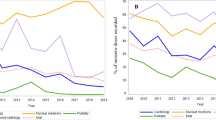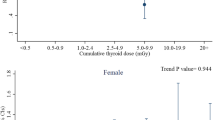Abstract
Purpose
Interventional medical radiation workers represent an under-studied population worldwide, although they receive relatively high occupational radiation doses. This study aimed to estimate the lifetime cancer risk from occupational radiation exposure among workers at interventional radiology departments.
Methods
A field survey of interventional medical workers in nationwide branches of the Korean Society of Interventional Radiology was conducted in 2017. Organ-specific radiation doses were estimated using national dose registry data and conversion coefficients provided by the International Commission on Radiological Protection. Lifetime attributable risk (LAR) and lifetime fractional risk (LFR) were calculated based on realistic exposure scenarios using a radiation risk assessment tool.
Results
LARs from occupational radiation exposure until the age of retirement for all cancers combined were 338 (90.3–796.1), 121 (33.5–288.7), and 156 (41.1–390.6) per 100,000 individuals for male radiologists, male radiologic technologists, and female nurses, respectively. LFR for all cancers combined ranged from 0.22% (0.06–0.53) to 0.63% (0.17–1.47). Regarding the organ site, the highest LAR and LFR among all groups were observed for thyroid cancer.
Conclusion
This study provides timely evidence of potential cancer burden from the current levels of occupational radiation exposure among workers at interventional radiology departments. The risks varied by occupational groups, and workers, particularly interventional radiologists, need to be carefully monitored for radiation.
Similar content being viewed by others
Availability of data and material
Data for the study will be provided upon inquiry to qualified individuals.
Code availability
Not applicable.
References
Bartal G, Roguin A, Paulo G (2016) Call for implementing a radiation protection culture in fluoroscopically guided interventional procedures. AJR Am J Roentgenol 206:1110–1111
Berrington de Gonzalez A, Iulian Apostoaei A, Veiga LH, Rajaraman P, Thomas BA, Hoffman FO, Gilbert E, Land C (2012) RadRAT: a radiation risk assessment tool for lifetime cancer risk projection. J Radiol Prot 32:205–222
Boice JD (2017) The linear nonthreshold (LNT) model as used in radiation protection: an NCRP update. Int J Radiat Biol 93:1079–1092
Choi Y, Cha ES, Bang YJ, Ko S, Ha M, Lee WJ (2018) Estimation of organ doses among diagnostic medical radiation workers in South Korea. Radiat Prot Dosimetry 179:142–150
Hornung RW, Reed LD (1990) Estimation of average concentration in the presence of nondetectable values. Appl Occup Environ Hyg 5:46–51
International Commission on Radiological Protection (ICRP) (1996) Conversion coefficients for use in radiological protection against external radiation. ICRP Publication 74. Ann ICRP 26:1–205
International Commission on Radiological Protection (ICRP) (2000) Avoidance of radiation injuries from medical interventional procedures. ICRP Publication 85. Ann ICRP 30:7–67
International Commission on Radiological Protection (ICRP) (2010) Conversion coefficients for radiological protection quantities for external radiation exposures. ICRP Publication 116. Ann ICRP 40:1–257
Kim JB, Lee J, Park K (2017) Radiation hazards to vascular surgeon and scrub nurse in mobile fluoroscopy equipped hybrid vascular room. Ann Surg Treat Res 92:156–163
Jang MY, Lee WJ, Chun BC, Cha ES (2020) Occupational radiation procedures and doses among nurses in South Korea. Radiat Prot Dosim 188:493–502
Jung KW, Won YJ, Kong HJ, Lee ES (2019) Cancer statistics in Korea: incidence, mortality, survival, and prevalence in 2016. Cancer Res Treat 51:417–430
Ko S, Chung HH, Cho SB, Jin YW, Kim KP, Ha M, Bang YJ, Ha YW, Lee WJ (2017) Occupational radiation exposure and its health effects on interventional medical workers: study protocol for a prospective cohort study. BMJ Open 7:e018333
Ko S, Kang S, Ha M, Kim J, Jun JK, Kong KA, Lee WJ (2018) Health effects from occupational radiation exposure among fluoroscopy-guided interventional medical workers: a systematic review. J Vasc Interv Radiol 29:353–366
Korea Centers for Disease Control and Prevention (KCDC) (2018a) 2018 Report occupational radiation exposure in diagnostic radiology in Korea. https://www.cdc.go.kr. Accessed 13 Feb 2020
Korea Centers for Disease Control and Prevention (KCDC) (2018) A cohort enrollment of medical interventional radiation workers. Osong, KCDC
Lee WJ, Choi Y, Ko S, Cha ES, Kim J, Kim YM, Kong KA, Seo S, Bang YJ, Ha YW (2018) Projected lifetime cancer risks from occupational radiation exposure among diagnostic medical radiation workers in South Korea. BMC Cancer 18:1206
National Research Council (NRC) (2006) Health risks from exposure to low levels of ionizing radiation: BEIR VII phase 2. National Academies Press, New York
Niklason LT, Marx MV, Chan HP (1993) Interventional radiologists: occupational radiation doses and risks. Radiology 187:729–733
Ramos M, Montoro A, Almonacid M, Ferrer S, Barquinero JF, Tortosa R, Verdú G, Rodríguez P, Barrios LL, Villaescusa JI (2010) Radiation effects analysis in a group of interventional radiologists using biological and physical dosimetry methods. Eur J Radiol 75:259–264
Shore RE, Beck HL, Boice JD, Caffrey EA, Davis S, Grogan HA, Mettler FA, Preston RJ, Till JE, Wakeford R, Walsh L, Dauer LT (2018) Implications of recent epidemiologic studies for the linear nonthreshold model and radiation protection. J Radiol Prot 38:1217–1233
Simon SL, Weinstock RM, Doody MM, Neton J, Wenzl T, Stewart P, Mohan AK, Yoder RC, Hauptmann M, Freedman DM, Cardarelli J, Feng HA, Bouville A, Linet M (2006) Estimating historical radiation doses to a cohort of US radiologic technologists. Radiat Res 166(1 Pt 2):174–192
Sun Z, Inskip PD, Wang J, Kwon D, Zhao Y, Zhang L, Wang Q, Fan S (2016) Solid cancer incidence among Chinese medical diagnostic X-ray workers, 1950–1995: estimation of radiation-related risks. Int J Cancer 138(12):2875–2883
Venneri L, Rossi F, Botto N, Andreassi MG, Salcone N, Emad A, Lazzeri M, Gori C, Vano E, Picano E (2009) Cancer risk from professional exposure in staff working in cardiac catheterization laboratory: insights from the National Research Council’s Biological Effects Of Ionizing Radiation VII Report. Am Heart J 157:118–124
Yun JW, Cha ES, Ko S, Lee WJ (2017) Work practices and radiation exposure among male radiologic technologists assisting fluoroscopically guided interventional procedures. Radiat Prot Dosimetry 176:418–424
UNSCEAR (2008) Effects of ionizing radiation: UNSCEAR 2006 report to the general assembly, with scientific annexes. Volume I. Effects of ionizing radiation. United Nations Publications, New York
Funding
This work was supported by the National Research Foundation of Korea (NRF) Grant funded by the Korea government (MSIT) (no. 2020R1A2C1008891).
Author information
Authors and Affiliations
Corresponding author
Ethics declarations
Conflict of interest
None.
Ethics approval
The Korea University Institutional Review Board approved the protocol for this study (KU-IRB-17-36-A-2).
Consent to participate
All participants provided their written informed consent to participate in the study.
Additional information
Publisher's Note
Springer Nature remains neutral with regard to jurisdictional claims in published maps and institutional affiliations.
Electronic supplementary material
Below is the link to the electronic supplementary material.
Rights and permissions
About this article
Cite this article
Lee, W.J., Bang, Y.J., Cha, E.S. et al. Lifetime cancer risks from occupational radiation exposure among workers at interventional radiology departments. Int Arch Occup Environ Health 94, 139–145 (2021). https://doi.org/10.1007/s00420-020-01569-8
Received:
Accepted:
Published:
Issue Date:
DOI: https://doi.org/10.1007/s00420-020-01569-8




